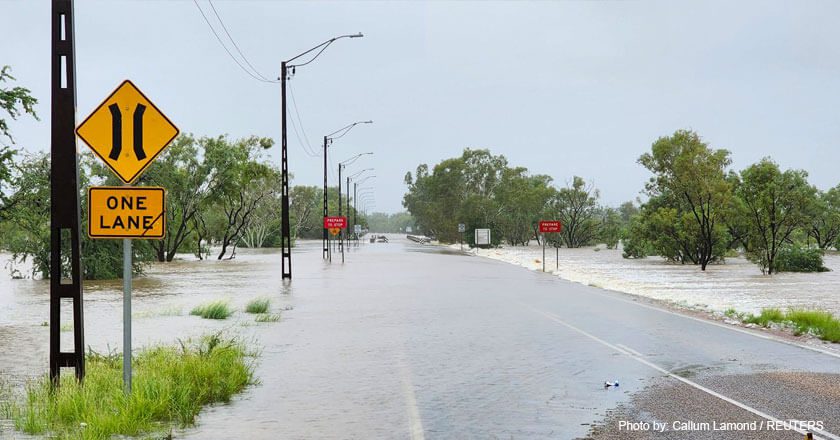Here’s Why River Overflow can Lead to Flood Damage
December 3, 2020 | Created by: Andreas Klippe | Comments
Flood can be very terrifying if you live near rivers. Though called in many literature as a source of life, rivers can actually take lives when they overflow. Rivers carry many risks especially when there is heavy rainfall and overtopping happens. When there is too much water because of very high rainfall volume, water can burst in the banks, causing dry areas to be flooded.

WHAT CAUSES RIVER OVERFLOW?
Though flooding can be attributed to excessive rainfall, there are other factors that play different roles in the overflowing of rivers.
One of these factors is the prevailing mining operations. Mining, both underground and above ground, have caused flood risks to the residents near rivers. Earlier this year, a major flooding in Samarinda, Indonesia was experienced after hours of heavy rain caused the Mahakam River to overflow. Samarinda City sits along the Mahakam River. Some people attribute the incident to deforestation caused by mining; some to unmonitored or abandoned mining pits. Whichever of the two, mining in general has reduced the land’s ability to absorb water, which led to overland flow.

Aside from mining, faulty man-made dams can also cause river overflows. One of the dams’ primary purposes is for flood control. The water from rainfall that could have flooded the lowlands is stored in dams. Eventually, this water is used for generating hydroelectricity and for sustaining irrigation projects. This is all ideal and good when there is just moderate rainfall. However when torrential rain pours and dams can no longer hold the water, the soundest decision to make is to release it to rivers or other bodies of water. A research paper titled, “Dams and Floods” says that “dams are often designed with very poor knowledge of the potential for extreme flood events.”
The recent flooding situation in Cagayan and Isabela in the advent of Typhoon Ulysses, international name Vamco, was blamed on the release of water from Magat Dam in North Luzon, Philippines, among other factors. On November 12, 2020, from 5 PM to 4 AM the next day, seven gates of the dam were opened. The Philippine Atmospheric, Geophysical Astronomical and Services Administration (PAGASA) said that 6,706 cubic meters of water per second were released from the dams at maximum discharge. This caused the river to swell and submerged the surrounding areas.
Making matters worse is the presence of weakly-constructed dams. The substandard materials used in these dams can lead to dam failure. Dam failure is defined as an uncontrolled release of water due to structural breakdown. This is not insignificant because dam failure can lead to loss of lives and the washing away of valuable properties. At the account of Banqiao Dam burst, roughly 170,000 people were killed followed by reports of injuries, water contamination, and food shortages. This incident from Henan Province, China in 1975 is one of the best illustrations of dam failure.

WHAT ARE THE NEGATIVE EFFECTS OF RIVER OVERFLOW?
When Typhoon Ulysses, international name Vamco, struck the eastern and central regions of the Philippines, many of the houses, properties, and other sources of livelihood were damaged due to overspilling of rivers. The recent overflowing of the Marikina River is one best example of river overflow damage. In the midst of the typhoon on November 12, 2020, as of 11 AM, the Marikina River swelled up to 22 meters.

The water in the River cut through heavily people-crowded areas of Rizal Province, Quezon City, Marikina City and Pasig City. The overflowing off the river resulted in death and displacement of people and damage to properties.

Given the seriousness of the situation, it is high time that we should consider the danger of flooding due to river overflow.
WHAT CAN WE DO TO EASE FLOODING?
There are several ways to mitigate flooding as a result of river overflow.
One of which is improving our flood warning systems. Another is by providing people more information about their areas, the dams, and river overflows. However, these actions seem to be passive. What we need is for people to take a more proactive approach in this problem.
One approach, not very popular but is making its headline nowadays, is setting up flood barriers: the modern, easily installed and cost-effective ones. As the world experiences extreme weather conditions, we have to let go of our old ways and step up our game. It might hurt some but let us admit, some flood protection strategies are old fashioned and do more harm than good.
What we need is strong and quality-made flood protection. We need modern flood technology that can protect houses, businesses, schools, and government buildings especially if they are near rivers. The technology I am talking about is flood barriers: demountable flood barriers, mobile flood barriers, flood doors and gates, sliding, self-closing, automatic flood barriers, and permanent glass walls. The materials are made of light-weight marine grade aluminum, hot dipped-galvanized or stainless steel, non-rusting, and can be used for 50 years and longer. Moreover, these portable barriers can be deployed in the event of flooding and dismounted when no longer needed. They can even be stacked or stored in a designated area, ready for the next use.
People always say that prevention is always better than cure. As we wait for another typhoon to surface, should we wait for another river overflow to damage our properties or take away our families? Should we not want to be in a secure environment where we can sleep in the midst of a storm with an assurance that you and your properties are safe?
The choice is in your hands. To learn more about the latest flood protection technology, subscribe now to our Flood Expert Tips (IF YOU HAVEN’T YET!).
Stay safe and flood-free!






